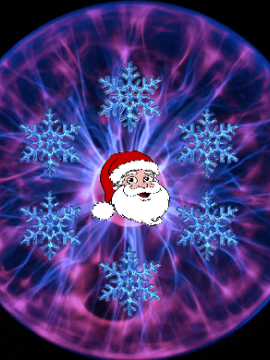The Physics of Santa Claus
I'm a geek, an atheist and [somewhat] pro-science but I still love Christmas so is it any surprise that I love humorous pieces like this one? It's arguably one of my all-time favourite pieces of Christmas fun. Bear in mind this was first published way back before the millennium so some of the figures are a little dated; for example, there are probably around two and half billion children in the world today compared to a mere two billion back then. Let us begin :)

On or around Christmas, Santa delivers presents to all the good children of the world. Like all claims, this needs to be rationally examined.

- No known species of reindeer can fly. BUT there are well over a million species of living organisms yet to be classified, and while most of these are insects and germs, this does not COMPLETELY rule out flying reindeer which only Santa has ever seen.
- There are 2 billion children (persons under 18) in the world. BUT since Santa doesn't (appear) to handle most Muslim, Hindu, and Buddhist children, that reduces the workload to 15% of the total - 378 million according to Population Reference Bureau. At an average (census) rate of 3.5 children per household, that's 91.8 million homes. One presumes there's at least one good child in each.
-
Santa has 31 hours of Christmas to work with, thanks to the different time zones and the rotation of the earth, assuming he travels east to west (which seems logical). This works out to 822.6 visits per second. This is to say that for each Christian household with good children, Santa has 1/1000th of a second to park, hop out of the sleigh, jump down the chimney, fill the stockings, distribute the remaining presents under the tree, eat whatever snacks have been left, get back up the chimney, get back into the sleigh and move on to the next house.
Assuming that each of these 91.8 million stops are evenly distributed around the earth (which, of course, we know to be false but for the purposes of our calculations we will accept), we are now talking about .78 miles per household, a total trip of 75┬Ż million miles, not counting stops to do what most of us must do at least once every 31 hours, plus feeding and etc.
 This means that Santa's sleigh is moving at 650 miles per second, 3,000 times the speed of sound. For purposes of comparison, the fastest man- made vehicle on earth, the Ulysses space probe, moves at a poky 27.4 miles per second - a conventional reindeer can run, tops, 15 miles per hour.
This means that Santa's sleigh is moving at 650 miles per second, 3,000 times the speed of sound. For purposes of comparison, the fastest man- made vehicle on earth, the Ulysses space probe, moves at a poky 27.4 miles per second - a conventional reindeer can run, tops, 15 miles per hour.
- The payload on the sleigh adds another interesting element. Assuming that each child gets nothing more than a medium-sized Lego set (2 pounds), the sleigh is carrying 321,300 tons, not counting Santa, who is invariably described as overweight. On land, conventional reindeer can pull no more than 300 pounds. Even granting that "flying reindeer" (see point #1) could pull TEN TIMES the normal amount, we cannot do the job with eight, or even nine. We need 214,200 reindeer. This increases the payload - not even counting the weight of the sleigh - to 353,430 tons. Again, for comparison, this is four times the weight of the cruise ship Queen Elizabeth II.
- 353,000 tons travelling at 650 miles per second creates enormous air resistance - this will heat the reindeer up in the same fashion as a spacecraft re-entering the earth's atmosphere. The lead pair of reindeer will absorb 14.3 QUINTILLION joules of energy. Per second. Each. In short, they will burst into flame almost instantaneously, exposing the reindeer behind them, and create deafening sonic booms in their wake. The entire reindeer team will be vaporized within 4.26 thousandths of a second. Santa, meanwhile, will be subjected to acceleration forces 17,500.06 times greater than gravity. A 250-pound Santa (which seems ludicrously slim) would be pinned to the back of his sleigh by 4,315,015 pounds of force.
Christmas Physics
Susan Shinkai
While pondering the existence of Santa Claus at a very young age, I was governed by the edict "Those who don't believe, don't receive". This ensured loyalty to the legend. However, over the years I developed the mind of a scientist and I collected sufficient evidence to lead me to postulate the theory of Christmas Physics, all of which explains Santa Claus and his reported doings.
 The shorter, colder days of winter and small children act as catalysts for this reaction. These catalysts allow beings with average amounts of "elves" (less than "Santa mass") to transform a limited amount of "santas".
Unfortunately, anti-santa energy, "humbug", can disrupt the local field effect of "santa" conversion. The origin of "humbug" is unknown but may be related to bad plum pudding and holiday traffic jams. The interaction of high-energy "humbug" and large "santa mass" can lead to the "scrooge cascade". The result of the cascade depends on the quanta of each in the interaction.
Of course, this theory is not restricted to Western cultural legends. As most large populations have similar legends, this must be a universal occurrence. Therefore, the Santa Claus story is not so much a fairy tale but a misunderstand of specialized physics.
The shorter, colder days of winter and small children act as catalysts for this reaction. These catalysts allow beings with average amounts of "elves" (less than "Santa mass") to transform a limited amount of "santas".
Unfortunately, anti-santa energy, "humbug", can disrupt the local field effect of "santa" conversion. The origin of "humbug" is unknown but may be related to bad plum pudding and holiday traffic jams. The interaction of high-energy "humbug" and large "santa mass" can lead to the "scrooge cascade". The result of the cascade depends on the quanta of each in the interaction.
Of course, this theory is not restricted to Western cultural legends. As most large populations have similar legends, this must be a universal occurrence. Therefore, the Santa Claus story is not so much a fairy tale but a misunderstand of specialized physics.
Naturally, I vastly prefer "The Physics of Santa Claus" and probably always will :)
Christmas Physics Theory
Christmas Physics is a distant cousin of quantum theory. The Christmas phenomenon energy units, or "santas", are convertible to units of standard energy, times and space. This allows the apparent impossibilities of flying reindeer, around-the-world trip in one night, etc. "santas" are generated by particles of "spirited" matter, known as "elves". "Elves" exists in nearly all living beings capable of doing good deeds or acts of kindness. As "santas" are generated, the being feels a sense joy/happiness/jolliness. However, a critical mass of "elves" must be present to start the energy transformation. Only certain beings have a high concentration of "elves" and can generate the huge "Santa mass" required. These are the "Santa ClausÔÇÖs of our legends. The shorter, colder days of winter and small children act as catalysts for this reaction. These catalysts allow beings with average amounts of "elves" (less than "Santa mass") to transform a limited amount of "santas".
Unfortunately, anti-santa energy, "humbug", can disrupt the local field effect of "santa" conversion. The origin of "humbug" is unknown but may be related to bad plum pudding and holiday traffic jams. The interaction of high-energy "humbug" and large "santa mass" can lead to the "scrooge cascade". The result of the cascade depends on the quanta of each in the interaction.
Of course, this theory is not restricted to Western cultural legends. As most large populations have similar legends, this must be a universal occurrence. Therefore, the Santa Claus story is not so much a fairy tale but a misunderstand of specialized physics.
The shorter, colder days of winter and small children act as catalysts for this reaction. These catalysts allow beings with average amounts of "elves" (less than "Santa mass") to transform a limited amount of "santas".
Unfortunately, anti-santa energy, "humbug", can disrupt the local field effect of "santa" conversion. The origin of "humbug" is unknown but may be related to bad plum pudding and holiday traffic jams. The interaction of high-energy "humbug" and large "santa mass" can lead to the "scrooge cascade". The result of the cascade depends on the quanta of each in the interaction.
Of course, this theory is not restricted to Western cultural legends. As most large populations have similar legends, this must be a universal occurrence. Therefore, the Santa Claus story is not so much a fairy tale but a misunderstand of specialized physics.



